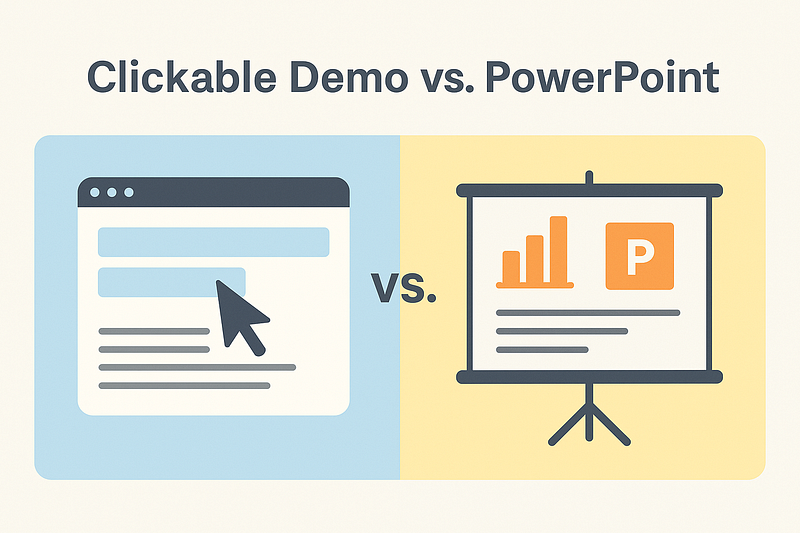The CTO’s Edge: Demo-First Leadership in the Era of AI
If you’ve ever pitched a big idea to the board or exec team, you know the feeling. You’re leaning in, waving your hands, excited about the…

If you’ve ever pitched a big idea to the board or exec team, you know the feeling. You’re leaning in, waving your hands, excited about the future. Meanwhile, you catch that look across the table. The CEO is nodding, but not really nodding. The CFO is scrolling through their phone. It’s not that they don’t care. But when the ask is huge, like going all in on AI or rebuilding critical platforms, suddenly excitement meets blank stares or worse, skepticism.
Honestly, I get it. Tech leaders speak in terms of architecture; boards talk in terms of outcomes. We obsess over frameworks and models, but they care about risk, impact, and what this thing is actually going to do for their business. They don’t need the blueprint; they want the so what factor.
Here’s the truth: trying to win buy-in with a static slide deck on some bold AI vision is a slog. It feels fuzzy, expensive, risky, like another round of maybe next year. I’ve lived this…more times than I’d like to admit.
The Technology Gap: Why Slides Just Don’t Cut It
Let’s be blunt. When you drop “AI-powered customer portal” on a Word doc, it’s just words. No matter how many bullet points or diagrams you use, the non-technical folks have to turn fuzzy ideas into mental pictures, and that rarely ends well. Instead of excitement, you get anxiety. Instead of alignment, hesitation.
And honestly, it’s not their fault. If roles were reversed and the CMO pitched a new branding strategy using engineering lingo, we’d zone out too.
Why Demos Change Everything
That’s why showing instead of telling is the fastest way to flip the room. The first time I walked a board through a clickable demo, something changed. I didn’t just tell them “AI will transform customer experience.” I showed them:
- A customer logs in and gets instant, relevant recommendations.
- Support tickets solved by an on-screen AI agent in seconds.
- Executives get plain-English answers, no SQL needed.
Suddenly, the skepticism melted away. It was no longer “Do we even need this?” It became “How fast can we get this live?” That rush when everyone is picturing the same future is electrifying.
How Demo-First Leadership Works
You don’t have to be a designer. You need to nail a few things:
1. Pinpoint the Vision Moment.
What’s the single “wow” interaction that proves your idea’s value? Is it the moment a customer signs up in sixty seconds? The bot that solves 95% of support requests in one shot? Pick the scene that changes the game.
2. Map the Journey, No Jargon.
Please keep it simple. Think story, not system.
Example: Onboarding isn’t “OAuth config” and “schema population.” It’s:
“Customer signs up, system configures, guided tour launches.”
3. Prototype and Play.
Learn to use one of the lovable-like tools available. Even an ugly clickable demo is better than pure slides. Walk through what matters: the flow, the smile, the instant answer. Remember, speed and delight, not plumbing.
4. Tie It to What They Care About.
Features fade but outcomes stick.
Onboarding: Faster onboarding means higher adoption, which translates to faster revenue recognition.
Support: Resolved in seconds means lower support costs, happier customers, and greater retention rates.
5. Sell the Future State, Not the Demo.
You’re not demoing software; you’re demoing tomorrow’s business. Walk them through the win as if you’re already there. “See, with this, our NPS shoots up and customers onboard themselves. Imagine scaling that.”
The Emotional Shift: From Doubt to Belief
The brutal reality is that in executive meetings and boardrooms, slides never truly change minds. But a great demo closes the gap quickly. I’ve seen skeptical directors sit up, lean in, and start asking, “I can finally see what you’ve been talking about,” and “Can we go even further?” That feeling when people get it is fuel. You leave the room with momentum, not a list of “maybe next quarter” excuses.
And it’s not just about AI. It works for any bold move, such as modernization, cloud, or a brand-new product. Whenever the vision feels too abstract to touch, a demo makes it real.
Bring the Room With You
Picture walking into your next board meeting, skipping the deck, and just showing them:
- “Here’s how a new customer sees our platform. Setup done in minutes.”
- “Here’s how our support workflow shrinks from hours to seconds.”
- “Here’s how you, as an exec, pull live data without ever touching a spreadsheet.”
All the questions shift from “Why?” to “How soon?”
Final Thought
Look, I don’t hate slides. But I’ve learned there’s no comparison. The fastest way to turn skeptics into believers, and believers into champions, is to show them what’s possible. In the era of AI, that is survival.
So the next time you’re gearing up to explain your next big vision, show them. Make it real. That’s how leaders inspire conviction, and how the best ideas make it out of your head and into the world.
Stop explaining. Start showing.


